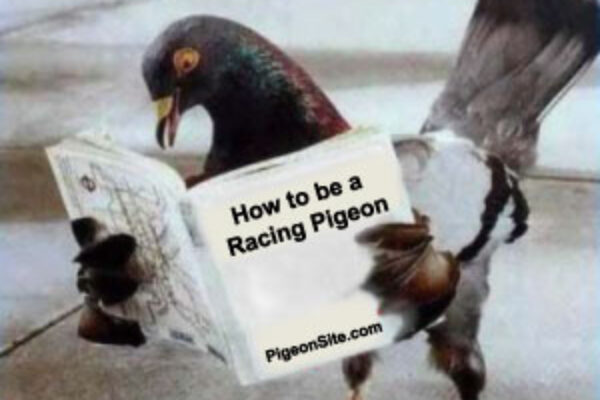The Pigeon Loft – Healthy Pigeons Win Races! Part 1
 In order for a pigeon loft to win consistently in tough competition four things are required.
In order for a pigeon loft to win consistently in tough competition four things are required.
You must fill your pigeon loft with good birds, the best you can obtain. Fit Birds They must be well conditioned motivated Birds They must want to come home fast healthy birds The most important factor. The reason that health is most important is that, you can spend a fortune on good pigeons , you can train their feathers of , you can fly natural, widowhood, lesbian hens, ect, but if they are not healthy you are going to get beat. Poor health is the equalizer in pigeon racing.
So if we assume that healthy pigeons win races, what do we mean by healthy pigeons? When I say healthy pigeons, I mean more than birds that look good, act good, fly around the loft well, have white wattles, have clear eyes and normal droppings. Why? Because a bird can fit the description that I just gave and not be healthy enough to win in big competition. That is because, it is the birds natural instinct to look healthy even when not. It is the sick bird that the predator gets in the wild and our pigeons maintain that instinct to act healthy even when not. We have all entered the pigeon loft to see a bird sitting on the floor all fluffed up that we thought was healthy the day before. Upon exam the bird is as light as a feather. It didn’t happen overnight. That bird has been slowly losing weight but trying to look healthy. Pigeons can be infected with all types of organisms such as coccidia, worms, trichomonas (canker), bacterial pathogens, ect. and look perfectly healthy in every way.
It is critical that we understand that there are 3 levels of pigeon health:
- Poor Health: This is when birds are sick and act sick. It is easy to see and birds obviously will not perform in this group. Most fanciers don’t keep or race their pigeons in this condition.
- Apparent Health: This is where we have birds that are apparently healthy in every way but are infected with various organisms that reduce performance. This is where the vast majority of pigeon fanciers keep their birds today.
- Super Health: This is the elusive goal that all of us who fly pigeons should strive for. It is the level that the top lofts who win year in and year out maintain their birds. Very few fanciers ever reach this level and when they do they have super results every week.
Stress is what causes a reduction in health and thus a reduction in performance. What things stress our birds?- training, breeding, racing, moulting, disease, parasites, husbandry problems, ect.
As we keep in mind the goal of keeping our birds in super health so they can give a super performance, we need to look at 4 specific areas. As we look at these areas, remember that we are seeking to reduce stress on our birds so that they can reach that super health.
- Pigeon Loft Hygiene
- Diseases of Concern
- A Realistic Health Program
- Pigeon Loft Design
This is a very critical but highly overlooked area as far as reducing stress on our birds is concerned. Many people could greatly enhance their performance by simply doing some minor remodeling to their pigeon lofts.
Ventilation: This is an extremely critical area. A pigeon’s lungs are connected to air sacs which go throughout their body and even into their bones. Anything a pigeon breathes will greatly affect it. If your pigeon loft is full of dust, ammonia fumes from wet droppings, ect. you can expect your performance to decrease. Ideally, air should enter from the floor and exit at the top. You do not want a breeze blowing through the loft at the other extreme. One way to greatly help you in the area of ventilation, especially as you try to balance it with temperature control is to not OVERCROWD your birds. You can keep a much tighter pigeon loft and thus control your temperature if you don’t have a ton of pigeons.
Droppings: In short, scrape the loft daily. When a pigeon has coccidia or worms, those organisms are passed in the droppings. They are not, however, infective at that point. They have to sit around for 48 hours or so before they will reinfect a pigeon when eaten. If you will scrape daily you will greatly reduce the reinfection rate in your birds with coccidia and worms. You also will reduce the problems with bacterial diseases like E. coli.
Moisture: Moisture is the pigeon flyers greatest enemy when it comes to health. Moisture greatly increases the viability of parasites and viruses. It is critical that you don’t allow rain to enter the pigeon loft, waterers to leak, ect. You must also be carefull with wire floors if they are open to the ground. In some cases this allows a lot of dampness into the loft which will spell disaster with your bird’s health. Building a wooden subfloor underneath the wire will help in this area. The best floor litter I have ever seen as far as dryness was suggested to me by Gunnar Guttormson. He uses compressed wood pellets that are sold as fuel for wood stoves. They absorb a tremendous amount of moisture and will keep your loft bone dry.
Food and Water: Three things to remember CLEAN, CLEAN, CLEAN. The easiest way for a bird to become infected with disease causing organisms is via soiled food or water. Thoroughly clean and sterilize your waterers with clorox (bleach) at least weekly.
Rodent control: Mice carry paratyphoid, the disease caused by salmonella. You must keep them out of the pigeon loft.
Temperature control: Big temperature fluctuations will kill form in your birds by the stress they cause. Closing up the pigeon loft at night and on cold days, especially during the race season is critical to top performance. Some form of heat is also extremely helpful to reach and maintain that super health needed to win in big competition.
Insect control: Several types of worms are carried by insects. Be careful about letting birds have a lot of open loft where they can eat insects.
Overcrowding: Simply don’t do it. Many people have had their best young bird season ever after a major smash in training leaving them with only 1/3 of their team. The less birds you have the less disease you will have and the easier and cheaper it is to take care of them. You should be like the marines “you only want a few good men.”
Quarantine: Remember, many birds carry a ton of bad bugs and look healthy. All new pigeons should be wormed, treated for canker and coccidia, and placed on 10 days of Baytril or Cipro to get rid of salmonella BEFORE they are put in the general population.
The Pigeon Loft – Healthy Pigeons Win Races! Part 1 by Dr. Steive Weir DVM
The Leading Online Pigeon Racing and Racing Pigeons Magazine – The Pigeon Insider









HI
Very good information.
Thank you
Hi Chris another good article Brad.
I got all above in my brand new racing and breeding lofts what racing pigeon loft designing is concerned and a few more. Such as air purifiers, wet and dry central vacuum system, Panasonic Hygiene air conditioning system, extractor fans, blower fans, Hot and cold water inside my racing pigeon lofts. No heater though as my racing pigeon loft has volcanic rock insulation, quad glazing where needed and hurricane proof and tight winds power assisted shutters that’s also quad glazed.
very right .
Good article.I think the key is fewer pigeons.When I flew in the USA my biggest team was 25 birds.The other point is to know the capacity(distance) and when the bird is ready.Here in Mexico it is a differnt ball game completely-700 miles of desert to cross and not a drop of water-survival of the fittest.The best I did was 5th National but I have 50% of my birds left. I think I’m doing OK. We have a viral epidemic. I don’t have a lab at my disposal as I did in the USA but it seems to be edenovirus.
what part of mexico do you live in? I live in Arizona its hot here. I was in Mexico for 2 years Didn’t come across any homing pigeons. Do you have
a big club?
The best way to fly pigeons is to adapt this system KISS. KEEP IT SYMPLE STUPID.
very nice information
Good reading ,i am not having a good year as yet i do not Know what is wrong
Regards TREV
EmaIL ME MAYBE I CAN HELP YOU [email protected] lets start this year off right.
HI, SIR ………
I HAVE HIGH FLYING PIGEONS
THIS IS THE SEASON LIKE APRIL TO MAY 2 MONTHS WE HAVE COMPETTION HIGH FLYING AND WE HAVE TO FLY OUR PIGEON DURING THIS SUMMER SEASON WE START OUR PIGEON TRANING REMEMBER WE HAVE TO FLY OUR PIGEON MORNING 6am PIGEON HAS TO PERFORM UNDER THE HEAT HERE IN MY CITY TEMPERATURE AROND 40DEGREE ITS VERY HARD TOTAKE CARE AND CONTROL OUR PIGEON AFTER FLYING MINUMUM HE HAS TO FLY 5 HOUR A DAY AFTER FLY MY PIGEON HOW ILL TAKE CARE I DONT KNOW CAN U GIVE SOME TIPS PLSSSSSSSS HELP THANK YOU PLS MAIL ME MY MAIL IS [email protected]
alot of comon sense in this post
regards
peter